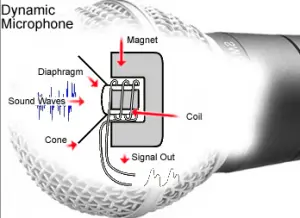Last week we talked about what it means to have a condenser microphone when I talked with Scott Roche about his CAD GXL2200 Condenser Microphone. Since we are we are chatting with Wayne Henderson about his Heil PR40, a dynamic Microphone, it makes sense to look at what that means.

Like the condenser microphone, the dynamic has a diaphragm but it is not free floating like the condenser. The diaphragm is attached to a coil of fine wire (see image below). The coil is mounted in the air gap of the magnet such that it is free to move back and forth within the gap.
When you are podcasting, your voice enters the microphone and strikes the diaphragm, and the diaphragm vibrates in response. The coil attached to the diaphragm shakes back and forth in the field of the magnet. As the coil moves through the lines of magnetic force in the gap, a small electrical current is created in the wire. The magnitude and direction of that current is directly related to the motion of the coil, which in turn in affected by the intensity and tone of your voice. The current is an electrical representation of the sound wave.
One of the major drawbacks of the dynamic microphone relates to the mass of its moving coil. Due to this mass, the dynamic mic has a relatively poor transient response (how quickly it responds to changes in the sound wave), and is less sensitive on the average than the condenser mic. Some dynamic microphones, like the Heil PR40, are touted as low mass dynamic microphones, suggesting they have a better transient response.
So the real question you must ask yourself is this: will I be recording in a setting, such as a convention, where I want to pick up ambient noise or am I trying filter out extraneous noise and focus only on my own voice?